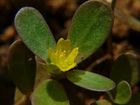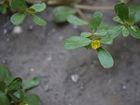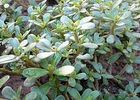Note: This is a project under development. The articles on this wiki are just being initiated and broadly incomplete. You can Help creating new pages.
Portulaca oleracea - Purslane
Dudagorai or Portulaca oleracea is an annual succulent in the family Portulacaceae, which may reach 40 centimetres (16 in) in height.Approximately forty cultivars are currently grown.
Contents
- 1 Uses
- 2 Parts Used
- 3 Chemical Composition
- 4 Common names
- 5 Properties
- 6 Habit
- 7 Identification
- 8 List of Ayurvedic medicine in which the herb is used
- 9 Where to get the saplings
- 10 Mode of Propagation
- 11 How to plant/cultivate
- 12 Commonly seen growing in areas
- 13 Photo Gallery
- 14 References
- 15 External Links
Uses
Snake bites, Boils, Snakebites, Sores, Skin eruptions, Pain from bee stings, Bacillary dysentery, Diarrhea, Hemorrhoids, Postpartum bleeding, Intestinal bleeding, Cold, Weak digestion.
Parts Used
Chemical Composition
Alpha-linolenic, 0.01 mg/g of eicosapentaenoic acid, vitamin A, vitamin C, Vitamin E (alpha-tocopherol) and some vitamin B and carotenoids.[1]
Common names
| Language | Common name |
|---|---|
| Kannada | ದೊಡ್ಡ ಗೋಣಿ ಸೊಪ್ಪು Dodda goni soppu |
| Hindi | Khursa, Kulfa |
| Malayalam | |
| Tamil | |
| Telugu | Boddupavilikoora, Boddupavilikura |
| Marathi | NA |
| Gujarathi | NA |
| Punjabi | NA |
| Kashmiri | NA |
| Sanskrit | Loni, Lonika |
| English | Common Indian Parselane |
Properties
Reference: Dravya - Substance, Rasa - Taste, Guna - Qualities, Veerya - Potency, Vipaka - Post-digesion effect, Karma - Pharmacological activity, Prabhava - Therepeutics.
Dravya
Rasa
Amla
Guna
Guru (Heavy), Ruksha (Dry)
Veerya
Ushna (Hot)
Vipaka
Kaphahar and Vatahar, Pittakara, Chakshuya, Vanidoshhar
Karma
Prabhava
Habit
Identification
Leaf
| Kind | Shape | Feature |
|---|---|---|
| Simple | lobed or unlobed but not separated into leaflets | Leaf arrangement is alternate there is one leaf per node along the stem and the edge of the leaf blade is entire (has no teeth or lobes) |
Flower
| Type | Size | Color and composition | Stamen | More information |
|---|---|---|---|---|
| Unisexual | 2-4cm long | Yellow | 10 | there are two or more ways to evenly divide the flower (the flower is radially symmetrical) |
Fruit
| Type | Size | Mass | Appearance | Seeds | More information |
|---|---|---|---|---|---|
| General | 4–7 mm | The fruit is dry and splits open when ripe | many | {{{6}}} |
Other features
List of Ayurvedic medicine in which the herb is used
Where to get the saplings
Mode of Propagation
How to plant/cultivate
Requires a moist light rich well-drained soil in a sunny position. [4]
Commonly seen growing in areas
At meadows, Borders of forests and fields.
Photo Gallery
References
- ↑ "Portulaca oleracea L on science direct"
- ↑ Cite error: Invalid
<ref>tag; no text was provided for refs namedCommon names - ↑ "Characteristics"
- ↑ "Cultivation details"
External Links
- Pages with reference errors
- Ayurvedic Herbs known to be helpful to treat Snake bites
- Ayurvedic Herbs known to be helpful to treat Boils
- Ayurvedic Herbs known to be helpful to treat Snakebites
- Ayurvedic Herbs known to be helpful to treat Sores
- Ayurvedic Herbs known to be helpful to treat Skin eruptions
- Ayurvedic Herbs known to be helpful to treat Pain from bee stings
- Ayurvedic Herbs known to be helpful to treat Bacillary dysentery
- Ayurvedic Herbs known to be helpful to treat Diarrhea
- Ayurvedic Herbs known to be helpful to treat Hemorrhoids
- Ayurvedic Herbs known to be helpful to treat Postpartum bleeding
- Ayurvedic Herbs known to be helpful to treat Intestinal bleeding
- Ayurvedic Herbs known to be helpful to treat Cold
- Ayurvedic Herbs known to be helpful to treat Weak digestion
- Herbs with Stem used in medicine
- Herbs with Leaves used in medicine
- Herbs with Flowers used in medicine
- Herbs with common name in Kannada
- Herbs with common name in Hindi
- Herbs with common name in Telugu
- Herbs with common name in Sanskrit
- Herbs with common name in English
- Habit - Annual herb
- Index of Plants which can be propagated by Seeds
- Index of Plants which can be propagated by Cuttings
- Herbs that are commonly seen in the region of At meadows
- Herbs that are commonly seen in the region of Borders of forests and fields
- Herbs
- Portulacaceae






